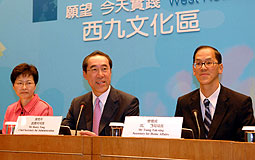 |
| Views sought: Secretary for Development Carrie Lam, Chief Secretary for Administration Henry Tang and Secretary for Home Affairs Tsang Tak-sing highlight recommendations from the consultative committee on developing the West Kowloon Cultural District. |
|
|
The Government has launched a three-month public consultation on recommendations put forward by the committee tasked with suggesting the way forward for the West Kowloon Cultural District, Chief Secretary for Administration Henry Tang announced today.
The Consultative Committee on the Core Arts & Cultural Facilities of the West Kowloon Cultural District recommended the public-engagement exercise, "to give people an opportunity to understand the overall picture of the project, the actual scale of the development and the quantum of public subsidy required for bringing West Kowloon Cultural District to fruition," its report said.
Chief among its recommendations is the establishment of a WKCD Authority, which should be set up primarily to implement the core arts and cultural facilities in the development. It should work within parameters based on the committee's recommendations, and that of its three advisory groups - Performing Arts & Tourism, Museums and Financial Matters. It should also take into account the outcome of previous public consultations and the new public-engagement exercise.
Mr Tang believes the cultural sector will support the recommendations as the report has taken into consideration their views. The Government will also lobby public support during the consultation with a view to having lawmakers endorse the recommendations.
He told the media at a press conference that along with developing finance, trade and logistics, Hong Kong must also nurture cultural and arts development.
Project's pricetag falls
Because the WKCD is viewed as an important strategic investment in culture and the arts for the future of Hong Kong, the committee also recommends an upfront endowment of $19 billion to develop and operate it in a self-sufficient and sustainable manner within the 40-hectare site. Earlier plans had suggested $30 billion would be needed for the project.
This $19 billion in funding, appropriated by the Legislative Council, would be roughly equal to the estimated land revenue from the residential, hotel and office part of commercial sites within the district. Mr Tang said these commercial sites would be sold through the normal land-sale mechanism.
The committee also suggests vesting the retail, dining and entertainment facilities with the WKCD Authority, to provide a steady source of recurrent income through rental proceeds to cover the operational deficits of the arts and cultural facilities.
Height restrictions to safeguard harbour view
Keeping in mind the public's desire for low-density development, the committee recommends setting the maximum overall plot ratio for the whole site at 1.81, giving a total gross floor area of about 726,000 square meters, capping the residential development at no more than 20% of this gross floor area, and imposing height restrictions to safeguard the harbour view.
To bridge the funding gap, the committee suggests a balanced development mix. This can be achieved by reducing the scale of the core arts and cultural facilities, to release more floor area for office development. The report also suggests a reduction in the planned hotel space by a third, and in retail, dining and entertainment facilities by one fifth, also allocating the released floor area for office development.
This would allow the district to capitalise on the potential to develop into an office node outside the central business district and provide a base load of weekday consumers for the retail, dining and entertainment facilities.
New type of cultural institution recommended
The committee has suggested there be 15 performing arts venues, 12 in the first phase, and three in the second. These would increase the total seting capacity of the city's performance venues by 37%.
It also puts forward a new type of cultural institution entitled M+, for "Museum Plus". It would focus on 20th and 21st century visual culture, including design, moving images, popular culture and visual art. It would provide the same amount of space as comparable renowned museums in other world cities, such as the Museum of Modern Art in New York and the Tate Modern Museum in London. This would increase by 52% the total space provided by existing museums.
Other space would be reserved for resident companies, meeting rooms and common facilities for artists and arts groups, arts-education venues, arts and cultural information centre.
Tangible, intangible benefits to flow from project
The committee's report says it "considers the WKCD project a timely and worthwhile strategic investment in Hong Kong's future, having regard to the strong economic recovery and the healthy fiscal situation. This should also be a major step to promote cultural and artistic activities in Hong Kong and a strategy that supports the long-term development of Hong Kong and its status as a world city."
It refers to an economic impact assessment that indicates the WKCD project is likely to bring substantial tangible economic impacts, including visitor spending and jobs creation. But there will also be "significant intangible benefits for the development of a creative economy, nurturing talents, attracting and retaining investors and talents, raising quality of life, reinforcing economic integration with the Pearl River Delta and branding Hong Kong as a world city."
Mr Tang agreed, saying he expected construction of residential and commercial facilities inside the district to bring more than 11,000 jobs. The number of tourists attracted to Hong Kong will rise to 450 million a year after the district has been in operation for 30 years, bringing an additional $3.7 billion in revenue.
On cultural development, Secretary for Home Affairs Tsang Tak-sing said accepting the committee's recommendations will help relieve the shortage of performance venues. Noting the hardware of cultural development will get a boost, Mr Tsang added more resources will also be allocated to support and promote arts development and strengthen arts education.
Go To Top
|



